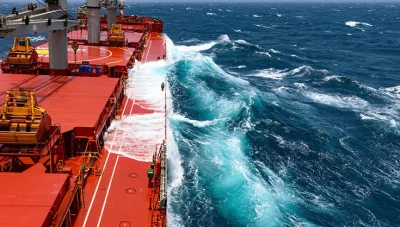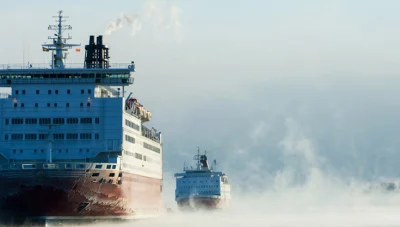Digital advancements to mitigate weather hazards
Despite more precise modern weather forecasting, unpredictable weather poses hazards to vessels and voyage scheduling. Climate change worsens these risks. To mitigate potential threats, additional measures are needed, made possible by digital technology advancements to manage risks and increase safety.
Climate change is well-documented to cause extreme weather events globally. Scientific studies indicate that the frequency and intensity of severe storms and disruptive weather patterns are projected to increase in the years ahead.
While rough weather, storm winds, and high waves have always been familiar challenges to mariners, the unprecedented scale of disruption that is now more frequently observed on the seas is a cause for concern. As sea temperatures rise and ocean currents and salinity levels shift, supercharged storms, higher wind speeds, and towering waves are becoming more common, increasing the risk of unexpected and severe weather events.
Sailing through unpredictable weather
Thanks to modern weather forecasting, leaders aboard and ashore can assess weather forecasts days in advance, enabling them to make informed decisions about routing that consider safety, fuel efficiency, and timeliness. But international voyages are typically much longer than this, often lasting weeks. Climate change can also cause sudden and severe storms that are difficult to predict with a high degree of accuracy.
For example, in 2019 Hurricane Dorian roared through the Atlantic in late August and early September, surprising many forecasters with its unexpected and rapid intensification. In just five days, Dorian grew from a minimal Category 1 hurricane to a Category 5 behemoth, reaching a peak intensity of 185 miles (295 kilometers) per hour.
The destructive effects of storms like these devastate the communities in their path, with far-reaching impacts on both the local and broader regions. They also cause extensive damage to coastal infrastructure near and around ports and pose significant risks to vessels in the vicinity.
In November 2020, the 14,000 TEU container ship ‘Apus’ became caught in a violent storm around 1,600 nautical miles northwest of Hawaii. More than 1,900 containers representing almost a quarter of the ship’s cargo, were either lost or damaged.
Massive storms with winds of up to 50 miles per hour (22 meters per second) and gusts twice that speed have been documented on the Great Lakes, resulting in wave heights of 30 to 40 feet (9 to 12 meters). Navigating through storms of this magnitude is unquestionably life threatening.
Even non-massive weather events, such as high winds and rough waters, can have a significant impact on vessels. These conditions can cause parametric and synchronous rolling, which can lead to instability and compromise the safety of the vessel and crew. In some cases, vessels may need to reroute or manoeuvre to compensate for these effects and ensure safe passage.
The effects of rolling
Synchronous rolling, when the ship’s rolling period becomes ‘synchronous’ with the period of wave encounter, can cause the vessel to heel over. If the vessel encounters a series of swell in such a manner that the wave period matches the natural rolling period, the vessel will have no time righting itself before the next wave strikes. This situation if not corrected, can result in the ship capsizing.

Then there is parametric rolling to contend with. When operating in heavy sea conditions, the angle of roll may increase to over 30 degrees in only a few wave cycles. The pitching motion effects of parametric rolling are particularly dangerous for vessels with a very fine bow and a wide and flat stern, such as large container ships. Parametric rolling causes heavy stress on the ship’s structure, especially the fore and aft parts. It also causes variation in the load of the ship’s main engines. If not tackled quickly, capsizing becomes a real possibility.
Fog and ice
Fog and ice present additional challenges for ships operating in colder climates. While modern weather forecasting provides advanced warning for storms and rough seas, fog and ice can develop rapidly and unpredictably. Reduced visibility caused by dense fog can obscure navigation hazards, making it difficult for the ship’s crew to determine the ship’s position and course. Ice can also be a significant hazard, especially in areas like the Northern Sea, where ships must navigate through frozen waters. Ice can damage a ship’s hull or propellers, leading to expensive repairs and potential safety hazards.
To manage these risks, ships operating in colder climates must take additional measures to ensure safety. Ships can be equipped with radar and other navigation aids to help them navigate through dense fog. In areas where ice is a significant hazard, ships can be equipped with reinforced hulls or icebreaking capabilities. In addition, modern digital technology can help ships avoid hazards associated with fog and ice.
By integrating real-time weather data and sophisticated navigation software, ships can optimize their routes to avoid areas with potential hazards, reducing the risk of accidents and increasing safety for crew and cargo. Despite these advances, unpredictable weather and associated hazards will continue to be a challenge for ships operating in colder climates, and continued investment in technology and safety measures will be necessary to mitigate these risks.

Managing the weather risk
To avoid bad weather, ships can alter their course, but this requires knowledge of when and where unfavorable conditions may arise. Preparedness for stormy seas is crucial for safe navigation. Even the largest ships will always roll on the ocean, as the sea is much larger.
To increase stability, heavy solid cargoes like iron ore or coal should be stored low down in the center of the vessel. For liquid carriers, partitions called ‘anti-slosh baffles’ can prevent destabilization caused by large liquid surges.
Ballast water can also help maintain stability by reducing the impact of rolling and pitching. The center of buoyancy and the KB, the height above the keel, are stabilized by the ballast exchange.
Cutting-edge digital software like OneOcean’s Weather simulator can provide critical information to predict a vessel’s roll. By utilizing forecasted weather and up-to-date hydrographical data, the simulator can anticipate the potential impact of the sea based on parameters like the vessel’s speed, course, and laden levels. This allows officers on board and shore-side teams to optimize the route and mitigate the adverse effects of unfavorable weather conditions. The simulator updates in real-time, providing continuous access to the most recent weather information.
Maximising precautions
Voyage optimisation with comprehensive weather routing has never been more important than it is today. Erratic weather patterns at sea are likely to increase as climate change continues. Yes, shipping has always to some extent been a risky business when sailing through waters, but now more than ever precautions need to be maximized. The latest digital technology from companies such as OneOcean is designed to manage these risks as best as possible.

